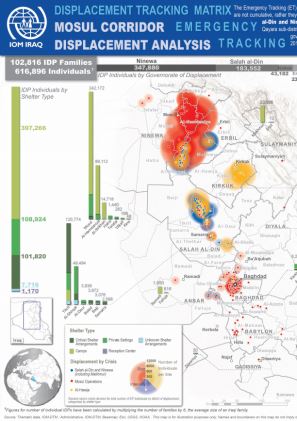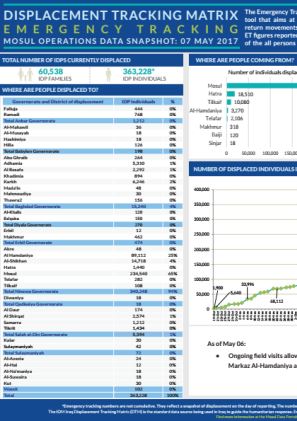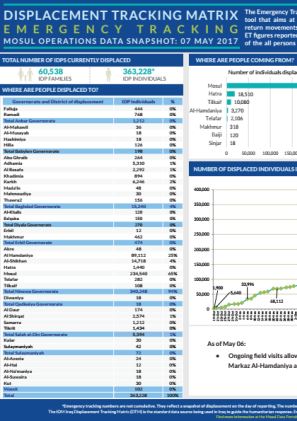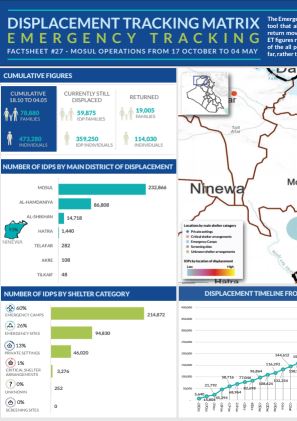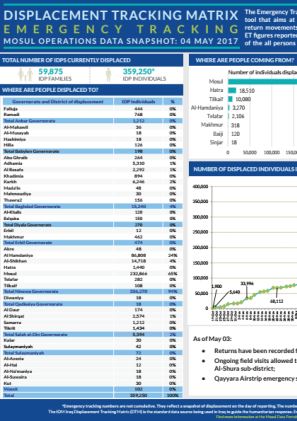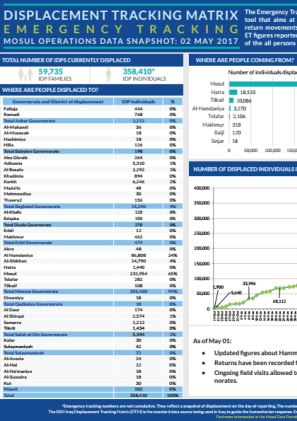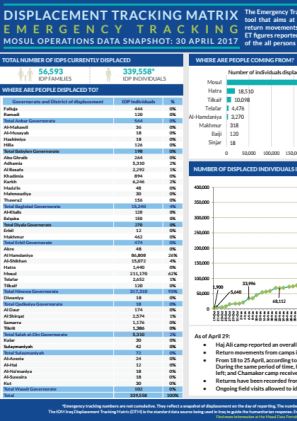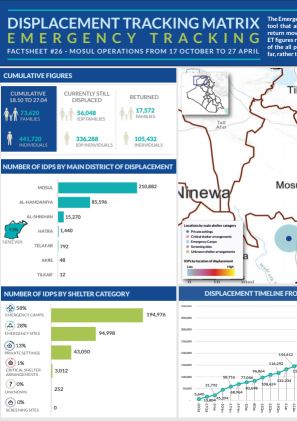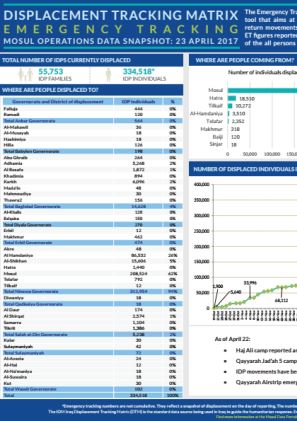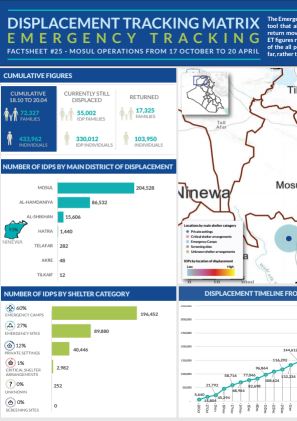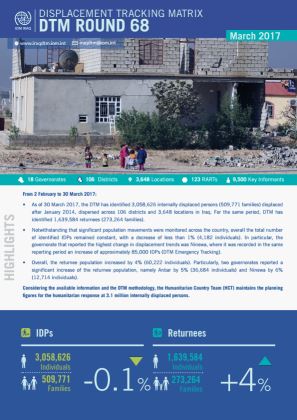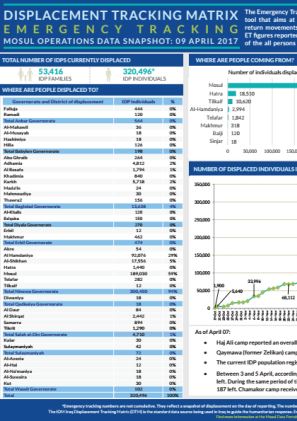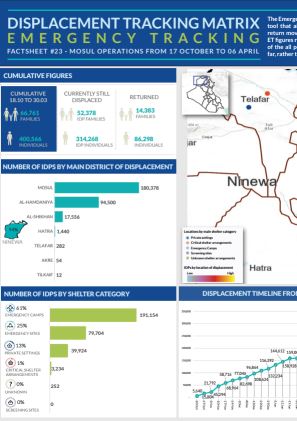-
Countries
-
Data and Analysis
-
Special Focus
-
Crisis Responses
Iraq
Desplazados internos rastreados
Movimientos de desplazamiento
1,124,000
IDMC 2023
Ronda de recopilación de datos
Sobre Iraq
Reinforced in January 2014 in response to the need for information on displacement linked to the worsening armed conflict, the DTM programme in Iraq collects key information on internally displaced persons (IDPs) and returnees through different components and methodologies across the entire country.
Through IOM's Rapid Assessment and Response Teams (RARTs) -composed of 140 field staff- present throughout the Iraqi territory, the DTM collects data on numbers and locations of IDPs and returnees using an extended network of over 4,000 key informants. In addition to information collected from key informants, identified locations hosting IDPs are then visited and directly assessed by the RARTs to collect more detailed and in-depth information on the displaced population.
Please visit the Access to Durable Solutions among IDPs in Iraq
Para obtener resultados de búsqueda más avanzados, vaya a la Página de búsqueda avanzada de informes
Iraq — Emergency Tracking Mosul Corridor Displacement Analysis (8 May 2017)
As of 8 May 2017 DTM has identified 102,816 displaced families. The majority (over 50%) of displaced persons were residing in camps, followed by private settings.
Iraq — Emergency Tracking Mosul Operations Data Snapshot (7 May 2017)
DTM identified 60,538 IDP families comprised of approximately 363,228 individuals. Mosul was the most commonly cited district of origin (328,806 individuals) followed by Hatra (18,510).
Iraq — Mosul Operations Data Snapshot (7 May 2017)
DTM identified 60,538 IDP families comprised of 363,228 individuals. The majority of the identified individuals (328,806) originated from Mosul. 313,680 people were living in camps/emergency sites and 46,020 people were living in private settings.
Iraq — Emergency Tracking Factsheet 27 (4 May 2017)
The cumulative total of IDPs recorded by DTM during this period was 473,280 individuals comprising 78,880 families. Of these, 359,250 individuals (comprising 59,875 families) are still displaced. 214,872 people are currently residing in emergency camps (60%).
Iraq — Mosul Operations Data Snapshot (4 May 2017)
DTM recorded 59,875 IDP families comprised of 359,250individuals. The majority of recorded IDPs originated from Mosul District (324,828 individuals). Most IDPs are living in camps or emergency sites (309,702 individuals).
Iraq — Mosul Operations Data Snapshot (2 May 2017)
DTM recorded 59,735 IDP families comprised of 258,410 individuals. The majority of recorded IDPs originated from Mosul District (323,982 individuals). Most IDPs are living in camps or emergency sites (309,492 individuals).
Iraq — Emergency Tracking Mosul Corridor Displacement Analysis (1 May 2017)
DTM recorded 98,488 IDP families comprised of 568,446 Individuals. The majority of IDPs were residing in Camps (374,034 individuals).
Iraq — Mosul Operations Data Snapshot (30 April 2017)
DTM recorded 56,593 IDP families comprised of 339,558 individuals. The majority of recorded IDPs originated from Mosul District (302,748 individuals). Most IDPs are living in camps or emergency sites (290,928 individuals).
Iraq — Emergency Tracking Factsheet 26 (27 April 2017)
The cumulative total of IDPs recorded by DTM during this period was 441,720 individuals comprising 73,630 families. Of these 336,288 individuals (comprising 56,048 families) are still displaced. 210,802 people are currently residing in emergency camps.
Iraq — Mosul Operations Data Snapshot (23 April 2017)
DTM identified 55,753 IDP families comprised of 334,518 individuals. The majority of the identified individuals (299,418) originated from Mosul. 290,328 people were living in camps/emergency sites and 40,956 people were living in private settings.
Iraq — Mosul Operations Data Snapshot (20 April 2017)
DTM recorded 55,002 IDP families comprised of 330,012 individuals. The majority of recorded IDPs originated from Mosul District (295,422 individuals). Most IDPs are living in camps or emergency sites (286,322 individuals).
Iraq — Emergency Tracking Factsheet 25 (20 April 2017)
The cumulative total of IDPs recorded by DTM during this period was 433,962 individuals comprising 72,327 families. Of these 330,012 individuals (comprising 55,002 families) are still displaced. 196,452 people are currently residing in emergency camps.
Iraq — Mosul Operations Data Snapshot (18 April 2017)
DTM recorded 55,190 IDP families comprised of 331,140 individuals. The majority of recorded IDPs originated from Mosul District (296,544 individuals). Most IDPs are living in camps or emergency sites (287,838 individuals).
Iraq — Emergency Tracking Mosul Corridor Displacement Analysis (17 April 2017)
DTM recorded 96,240 IDP families comprised of 577,440 Individuals. The majority of IDPs were residing in Camps (367,674 individuals). The Mosul Operations recorded the highest numbers of IDPs (327,432) of which most came from Mosul itself (292,824).
Iraq — Mosul Operations Data Snapshot (13 April 2017)
DTM recorded 54.572 IDP families comprised of 327,432 individuals. The majority of recorded IDPs originated from Mosul District (292,824 individuals). Most IDPs are living in camps or emergency sites (284,448 individuals).
Iraq — Emergency Tracking Factsheet 24 (13 April 2017)
The cumulative total of IDPs recorded by DTM during this period was 424,560 individuals comprising 70,760 families. Of these 327,432 individuals (comprising 54,572 families) are still displaced. 197,796 people are currently residing in emergency camps.
Iraq — Displacement Report 68 (March 2017)
DTM interviewed 9,500 key informants across 3,648 locations in 106 districts in 18 governorates. As of 30 March 2017, the DTM has identified 3,058,626 internally displaced persons (509,771 families) displaced after January 2014. DTM also recorded a 4% increase in the number of returnees.
Apr 12 2017
Iraq — Displacement Report 68 (March 2017)
Iraq — Mosul Operations Data Snapshot (11 April 2017)
DTM recorded 53,708 IDP families comprised of 322,248 individuals. The majority of recorded IDPs originated from Mosul District (287,604 individuals). Most IDPs are living in camps or emergency sites (279,264 individuals).
Iraq — Mosul Operations Data Snapshot (9 April 2017)
DTM recorded 53,416 IDP families comprised of 320,496 individuals. Ninewa Governorate currently hosts 94% of the total recorded IDP population (300,450 individuals). Mosul was most commonly cited as a district of origin with 286,074 individuals reporting this.
Iraq — Emergency Tracking Mosul Corridor Displacement Analysis (10 April 2017)
DTM recorded 94,741 IDP families comprised of 568,446 Individuals. The majority of IDPs were residing in Camps (360,312 individuals). Mosul hosts the most IDPs, 197,586 individuals, over 50% of which are living in camps.
Iraq — Mosul Operations Data Snapshot (6 April 2017)
DTM recorded 314,268 IDPs comprising 52,378 families across ten governorates. The governorate of Ninewa currently hosts the most IDPs, 294,222 (94% of the total). Mosul was the most commonly cited district of origin with 279,846 people recorded as originating from there.
Iraq — Emergency Tracking Factsheet 23 (6 April 2017)
The cumulative total of IDPs recorded by DTM during this period was 400,566 individuals comprising 66,761 families. Of these, 314,268 individuals (comprising 52,378 families) are still displaced. 191,154 people are currently residing in emergency camps.
Iraq — Mosul Operations Data Snapshot (4 April 2017)
DTM recorded 304,152 IDPs comprising 50,692 families across ten governorates. The governorate of Ninewa currently hosts the most IDPs, 284,622 (94% of the total). Mosul was the most commonly cited district of origin with 229,694 people recorded as originating from there.
Iraq — Emergency Tracking Mosul Corridor Displacement Analysis (3 April 2017)
DTM recorded 549,846 individuals (91,641 IDP families) as of 4 April 2017. 342,744 IDPs were found to be living in camps, 100,848 in critical shelter arrangements, 99,864 in private settings, 5,220 in unknown shelter arrangements and 1,170 in reception centres.
Pagination
Para obtener resultados de búsqueda más avanzados, vaya a la Página de búsqueda avanzada de conjuntos de datos
Pagination
- First page
- Previous page
- …
- 5
- 6
- 7
- 8
- 9
- 10
- 11
- 12
- 13


